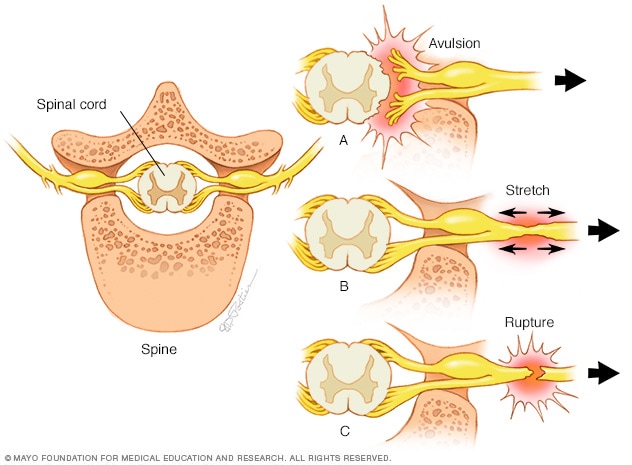Overview
The brachial plexus is the group of nerves that sends signals from the spinal cord to the shoulder, arm and hand. A brachial plexus injury happens when these nerves are stretched, squeezed together, or in the most serious cases, ripped apart or torn away from the spinal cord.
Minor brachial plexus injuries, called stingers or burners, are common in contact sports, such as football. Babies sometimes get brachial plexus injuries when they're born. Other health issues, such as inflammation or tumors, may affect the brachial plexus.
The most serious brachial plexus injuries happen during car or motorcycle accidents. Bad brachial plexus injuries can leave the arm paralyzed, but surgery may help.
The brachial plexus is the network of nerves that send signals from your spine to your shoulder, arm and hand.
Products & Services
Symptoms
Types of nerve damage

Types of nerve damage
Part of the spine (on left) shows how nerve roots connect to the spinal cord. The most serious types of nerve injuries are an avulsion (A), where the nerve roots are torn away from the spinal cord, and rupture (C), where the nerve is torn into two pieces. A less serious injury is stretching (B) of the nerve fibers.
Symptoms of a brachial plexus injury can differ depending on how serious the injury is and where it's located. Usually only one arm is affected.
Less severe injuries
Minor damage often happens during contact sports, such as football or wrestling, when the brachial plexus nerves get stretched or squeezed together. These are called stingers or burners. Some of the symptoms are:
- A feeling like an electric shock or a burning sensation shooting down the arm.
- Numbness and weakness in the arm.
These symptoms usually last only a few seconds or minutes, but in some people the symptoms may last for days or longer.
More-serious injuries
More-serious symptoms happen when an injury seriously damages or even tears or ruptures the nerves. The most serious brachial plexus injury is when the nerve root is cut or torn from the spinal cord.
Symptoms of serious injuries can include:
- Weakness or not being able to use certain muscles in the hand, arm or shoulder.
- Loss of feeling in the arm, including the shoulder and hand.
- Intense pain.
When to see a doctor
Brachial plexus injuries can cause lasting weakness or disability. Even if yours seems minor, you may need medical care. See your healthcare provider if you have:
- Burners and stingers that keep coming back, or symptoms that don't go away quickly.
- Weakness in the hand or arm.
- Neck pain.
- Symptoms in both arms.
Causes
Brachial plexus injuries in the upper nerves happen when the shoulder is forced down on one side of the body and the head is pushed to the other side in the opposite direction. The lower nerves are more likely to be injured when the arm is forced above the head.
These injuries can happen in many ways, including:
- Contact sports. Many football players have burners or stingers. These are caused when the brachial plexus nerves get stretched past their limit during clashes with other players.
- Birth. Newborns can have brachial plexus injuries. This is more common in babies with a high birth weight, a very long labor and a bottom-first, also called breech, presentation. If a baby's shoulders get stuck in the birth canal, brachial plexus palsy is more likely. Most often, the upper nerves are injured. This is called Erb palsy.
- Injuries. Many injuries — including those from motor vehicle accidents, motorcycle accidents, falls or bullet wounds — can damage the brachial plexus.
- Tumors and cancer treatments. Tumors can grow on their own. Rarely, they can form because of a health condition, such as neurofibromatosis, or after radiation treatment.
Risk factors
Playing contact sports, especially football and wrestling, or being in high-speed motor vehicle accidents increases the risk of brachial plexus injury.
Complications
Many mild brachial plexus injuries heal over time with few to no issues. But some injuries can cause short-term or lasting problems, such as:
- Stiff joints. If you have hand or arm paralysis, the joints can get stiff. This can make it hard to move, even if you are able to use your hand or arm again. For that reason, your healthcare professional may suggest ongoing physical therapy during your recovery.
- Pain. This is caused by nerve damage and may be lifelong.
- Numbness. If you lose feeling in the arm or hand, you're at risk of burning or injuring yourself without knowing it.
- Muscle atrophy. Nerves regrow slowly and can take many years to heal after injury. During that time, not using your muscles may cause them to break down.
- Permanent disability. How well you recover from a serious brachial plexus injury depends on many things, such as your age and the type, location and seriousness of the injury. Even with surgery, some people have muscle weakness or paralysis that lasts for the rest of their lives.
Prevention
Although a brachial plexus injury can't always be avoided, you can take steps to reduce your risk of complications after getting hurt:
-
For yourself. If you can't use the hand or arm for a short time, daily range-of-motion exercises and physical therapy can help prevent joint stiffness. Avoid burns or cuts, as you may not feel them if you have numbness.
If you're an athlete with a brachial plexus injury, your healthcare professional may suggest that you wear padding to protect the area when you play sports.
- For your child. If your child has brachial plexus palsy, it's important to exercise your child's joints and working muscles every day. You can start when your baby is just a few weeks old. This helps stop the joints from becoming permanently stiff. It also keeps your child's working muscles strong and healthy.